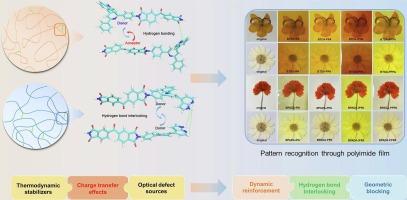DNA-inspired self-complementary architecture: Achieving stable decoupling of thermodynamic and optical properties in polyimides through orchestrated hydrogen bonding
IF 6.3
2区 化学
Q1 POLYMER SCIENCE
引用次数: 0
Abstract
DNA achieves the most stable molecular recognition and information storage system in nature by integrating structural artistry with functionality. Inspired by this, we developed a biomimetic strategy based on azaindole-modified diamines to construct self-complementary hydrogen bond networks in polyimides. This approach transforms conventional donor–acceptor chain stacking into donor–donor configurations. The DNA base-pairing-like molecular design significantly reduced the cutoff wavelengths in polyimide (>35 nm blue shift), while maintaining excellent thermodynamic stability (Td5% > 550 °C and CTE50-350°C: 15.4–33.6 ppm·K−1). The resulting materials exhibit exceptional electrical performance stability. The ketone-containing polyimide achieved outstanding breakdown strength (585.6 MV/m), while the ether-containing polyimide delivered high energy density (2.46 J/cm3 at 350 MV/m with 85 % efficiency). This “geometric blocking-dynamic reinforcement” mechanism enables stable property decoupling in polyimides, providing a practical design strategy for high-performance polyimide materials with simultaneously enhanced optical transparency and thermomechanical properties for flexible optoelectronic applications.

dna启发的自互补结构:通过精心安排的氢键实现聚酰亚胺的热力学和光学性质的稳定解耦
DNA通过将结构艺术性与功能性相结合,实现了自然界中最稳定的分子识别和信息存储系统。受此启发,我们开发了一种基于叠氮多尔修饰二胺的仿生策略,在聚酰亚胺中构建自互补的氢键网络。该方法将传统的供体-受体链堆叠转变为供体-供体构型。类似DNA碱基配对的分子设计显著降低了聚酰亚胺中的截止波长(>;35 nm蓝移),同时保持了优异的热力学稳定性(Td5% >; 550°C和CTE50-350°C: 15.4-33.6 ppm·K−1)。所得材料表现出优异的电气性能稳定性。含酮的聚酰亚胺具有出色的击穿强度(585.6 MV/m),而含醚的聚酰亚胺具有较高的能量密度(在350 MV/m时,能量密度为2.46 J/cm3,效率为85%)。这种“几何阻塞-动态增强”机制使聚酰亚胺的性能稳定解耦,为高性能聚酰亚胺材料提供了一种实用的设计策略,同时增强了柔性光电应用的光学透明度和热机械性能。
本文章由计算机程序翻译,如有差异,请以英文原文为准。
求助全文
约1分钟内获得全文
求助全文
来源期刊

European Polymer Journal
化学-高分子科学
CiteScore
9.90
自引率
10.00%
发文量
691
审稿时长
23 days
期刊介绍:
European Polymer Journal is dedicated to publishing work on fundamental and applied polymer chemistry and macromolecular materials. The journal covers all aspects of polymer synthesis, including polymerization mechanisms and chemical functional transformations, with a focus on novel polymers and the relationships between molecular structure and polymer properties. In addition, we welcome submissions on bio-based or renewable polymers, stimuli-responsive systems and polymer bio-hybrids. European Polymer Journal also publishes research on the biomedical application of polymers, including drug delivery and regenerative medicine. The main scope is covered but not limited to the following core research areas:
Polymer synthesis and functionalization
• Novel synthetic routes for polymerization, functional modification, controlled/living polymerization and precision polymers.
Stimuli-responsive polymers
• Including shape memory and self-healing polymers.
Supramolecular polymers and self-assembly
• Molecular recognition and higher order polymer structures.
Renewable and sustainable polymers
• Bio-based, biodegradable and anti-microbial polymers and polymeric bio-nanocomposites.
Polymers at interfaces and surfaces
• Chemistry and engineering of surfaces with biological relevance, including patterning, antifouling polymers and polymers for membrane applications.
Biomedical applications and nanomedicine
• Polymers for regenerative medicine, drug delivery molecular release and gene therapy
The scope of European Polymer Journal no longer includes Polymer Physics.
 求助内容:
求助内容: 应助结果提醒方式:
应助结果提醒方式:


